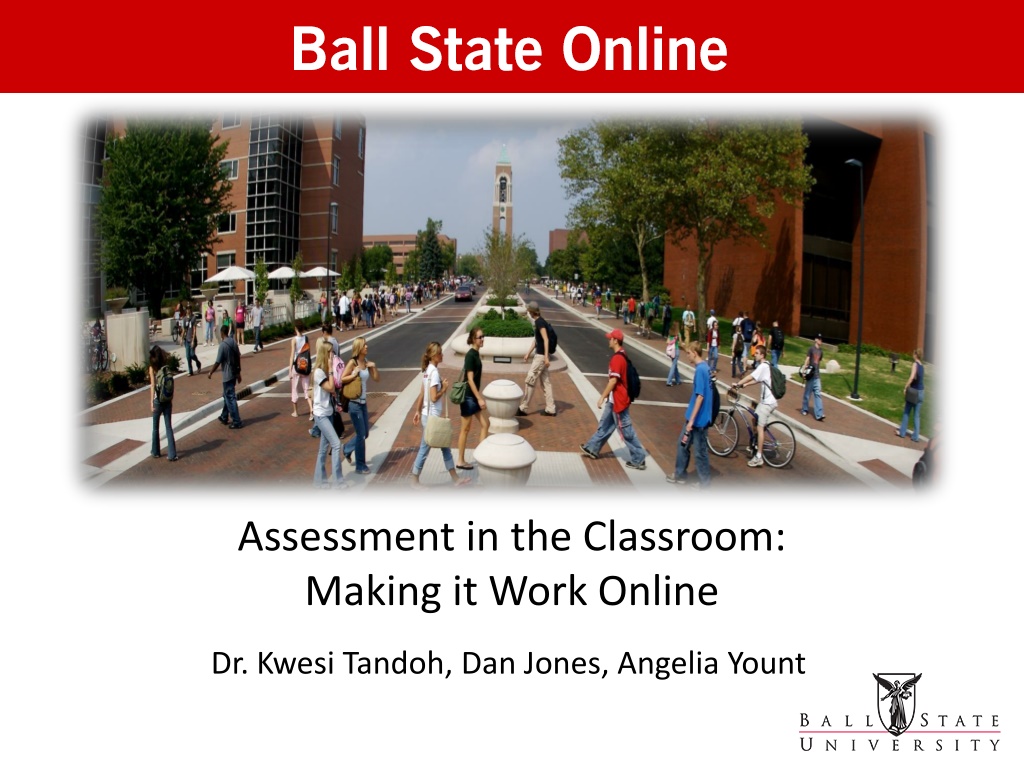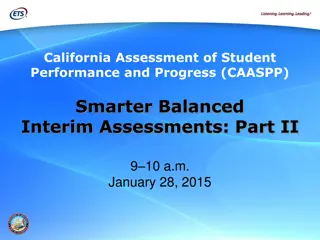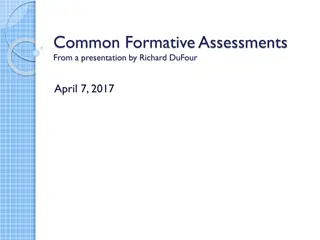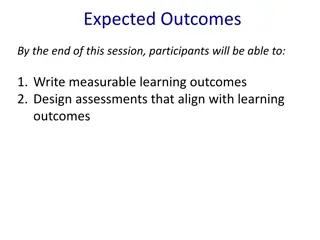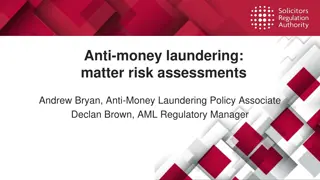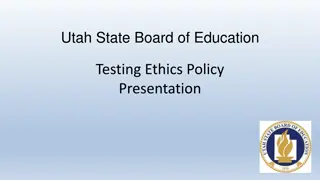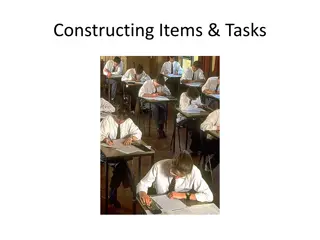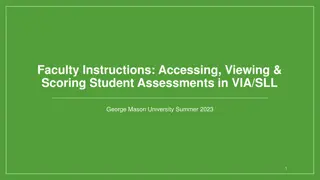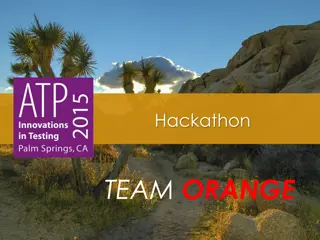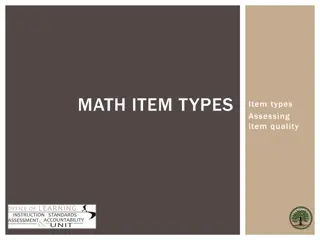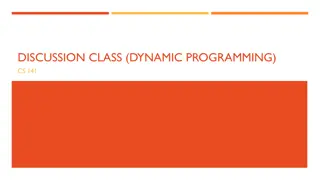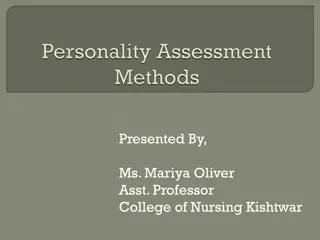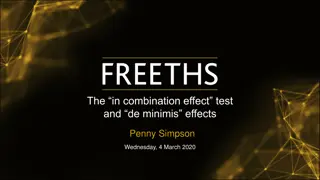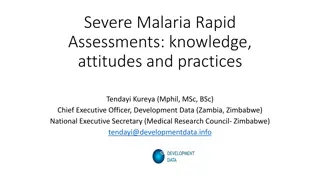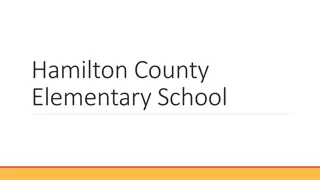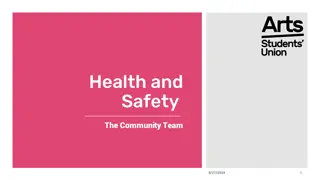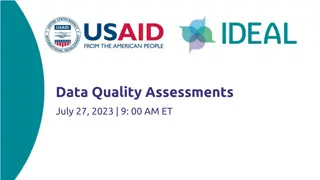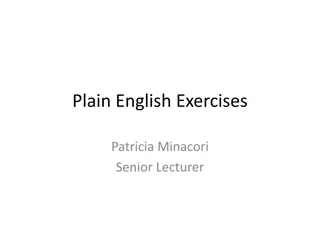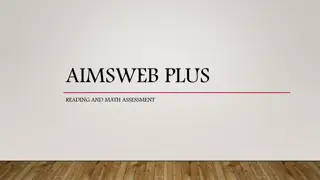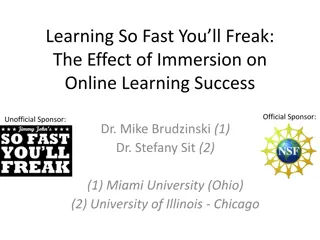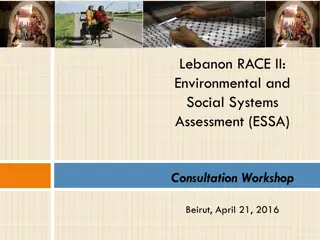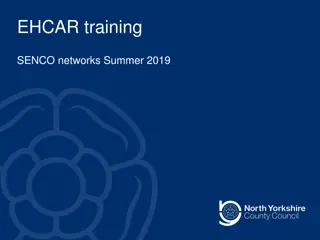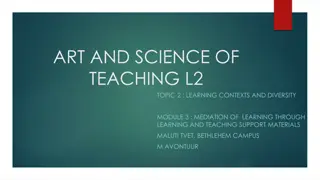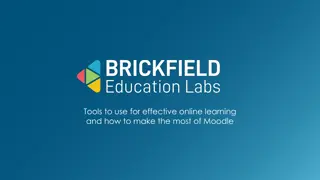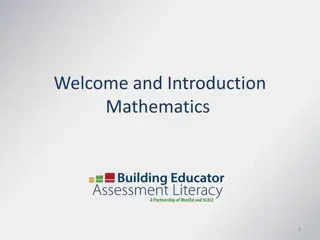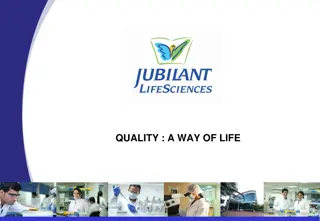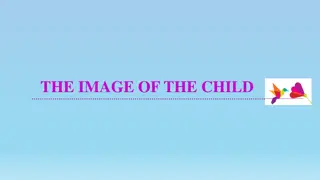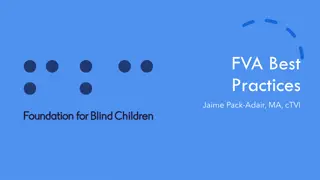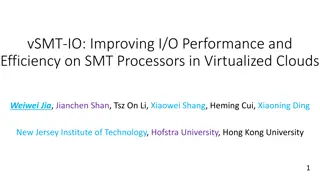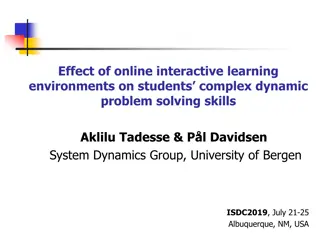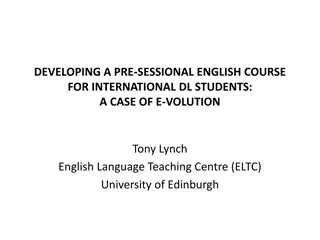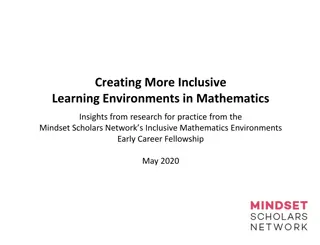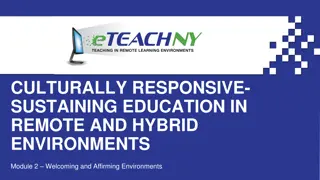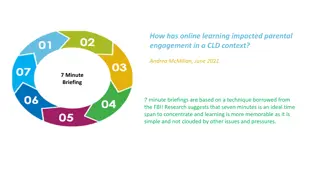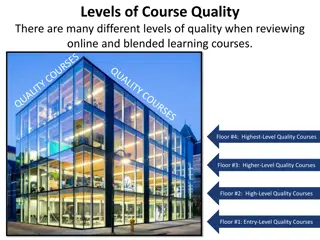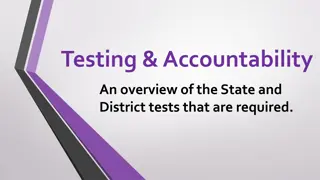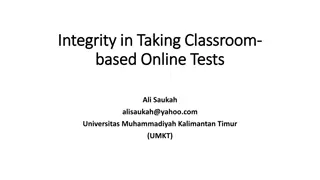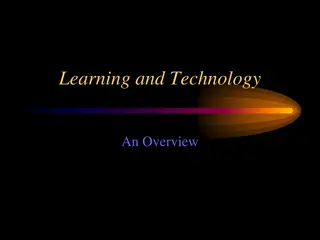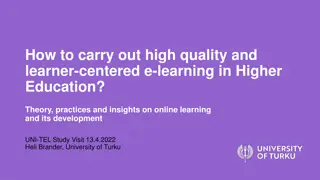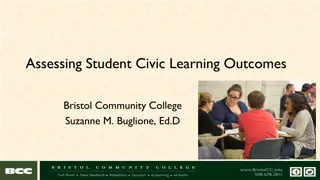Maximizing Quality Assessments in Online Learning Environments
Explore the differences between assessment and evaluation, understand the importance of assessing students, and learn about the various levels of assessment such as formative and interim assessments. Discover how to implement Quality Matters standards for effective online assessments.
Download Presentation

Please find below an Image/Link to download the presentation.
The content on the website is provided AS IS for your information and personal use only. It may not be sold, licensed, or shared on other websites without obtaining consent from the author. Download presentation by click this link. If you encounter any issues during the download, it is possible that the publisher has removed the file from their server.
E N D
Presentation Transcript
Assessment in the Classroom: Making it Work Online Dr. Kwesi Tandoh, Dan Jones, Angelia Yount
Presentation Objectives/Outcomes Define the terms assessment and authentic assessment. Differentiate between assessment and evaluation. Identify the different forms of assessment. Implement Quality Matters standards to maximize quality assessments in online learning.
Assessment vs. Evaluation? Assessment is: Gathering of evidence and documentation of learning. (Trussell-Cullen 1998) The gathering of information concerning the functioning of students, staff, and institutions of higher education and Evaluation as the use of that information for institutional and individual improvement. (Astin and Antonio, 2012) Process whereby teachers find out what students have learned in the classroom and how well they are learning. (Angelo & Cross 1993)
Assessment vs. Evaluation? On the other hand Evaluation is: Viewed as a process whereby we seek to interpret the assessment data and make appropriate professional judgments based on that data. (Trussell-Cullen 1998)
Why do we assess students? 1. Admissions 2. Guidance and Placement 3. Improve Teaching and Learning 4. Credentialing or Certification (Astin and Antonio, 2012)
Levels of Assessment Summative Interim Formative
Formative Assessment Formative 1. Occurs in the short term with prompt feedback 2. Allows learner to change behavior early 3. Allows instructor to: rethink instructional strategies improve student understanding and performance 4. Examples include: Interactive discussions, a warm-up, quiz
Interim Assessment 1. Helps instructors recognize gaps in instruction and student learning 2. Learner given opportunity to demonstrate understanding of material 3. Examples include: Chapter test Essays scored with a rubric Midterm Exam etc. 4. Feedback is prompt
Summative Assessment 1. Mainly at the end of the term or semester 2. Results mostly for teachers and institutional use 3. Very limited feedback to student 4. Least impact on student learning 5. Instructors and institutions use these to identify strengths and weaknesses of the curriculum 6. Examples include: Final Exam, GRE, Research Projects, musical recitals etc.
Types of Assessment Traditional Authentic / Alternative
What is Traditional Assessment? Students typically select an answer or recall information to complete the assessment. These tests may be standardized or teacher-created. They may be administered locally or statewide, or internationally. (Mueller 2005)
Examples of Traditional Assessment Written assessment-Unseen Exam: Multiple Choice Exams True-false Matching Open ended: Essay Written examination
Unseen Exam What is it? This is the traditional form of summative assessment. Students answer a number of questions such as, essay, problem, short-answer or multiple-choice. Students have either minimal or no prior information, and have to produce answers in a set period, with recourse to no other resources than those in their heads, or specific equipment provided by the examiner.
Unseen Exam Pros and Cons Pros Mostly takes place in a highly controlled and proctored environment. Very secure It is one of the few ways of ensuring that students revise the entire course material, and commit it to memory. Cons Encourages regurgitation or rote learning whether the material is relevant or not. Examinations typically generate high degrees of anxiety, amounting to cognitive paralysis on the part of some candidates. Requires very specific skills, which may well be irrelevant to the subject being examined, and are therefore often low on validity, but high on discrimination potential. Promotes guessing and discourages authentic learning.
Pros and Cons of Traditional Assessment Pros Cost-effective Minimizes plagiarism Encourages student learning Cons Low feedback Does not help theory/practice gap Encourages rote learning Does not measure teamwork etc. Reveal only whether student can recognize, recall, or plug in what was learned out of contest Limited to paper and pencil
What is Authentic Assessment? Students are asked to perform real-world tasks that demonstrate meaningful application of essential knowledge and skills. (Jon Mueller, 2005) ...Engaging and worthy problems or questions of importance, in which students must use knowledge to fashion performances effectively and creatively. (Wiggins, 1993). Call upon the examinee to demonstrate specific skills and competencies." (Stiggins, 1987). Directly examines student performance on worthy intellectual tasks. (Wiggins, 1990).
Examples of Authentic Assessment Case Studies Simulations Projects Presentations Portfolios Musical Recitals
What is a Case Study? A case is the study which investigates specific research questions(that may be fairly loose from the beginning) and seeks to use a range of different kinds of evidence(each with its own strengths and weaknesses) in the case setting to get the best possible answers (Gilham, 2000) Can be a unit of human activity linked to real world issue Can only be studied or understood in context Exists in the here and now It can be an individual: group- such as a team, tribe It can be large scale: a community, an institution
Case Study Pros and Cons Pros Excellent for assessment of application of principles to real- world situations. Provides useful information for formative purposes, including diagnosis of problems. Cons It is not ideal in a context where criteria for assessment of correct or successful answers are contestable or unclear. Requires a degree of sophistication on the part of students. The design and the grading of case-study based work is time- consuming
What is a portfolio? A collection, usually of items(focused artifacts) which are prepared for a purpose or assessment Pros Shows evidence of assembled information to show how the student has met specified learning outcomes or assessment criteria. Valuable for the assessment of vocational or professional practice including work experience placements often in conjunction with direct observation. Cons Evidence is not easy to come by Often too cumbersome to navigate
Authentic Assessment Pros and Cons Pros Uses direct measures that allows students to use acquired skills Uses task that mirror priorities and challenges found in best instructional activities research, writing, oral presentations Captures constructive nature of learning Integrates teaching, learning, and assessment Provides multiple paths to demonstrate student learning Cons Too cumbersome and often hard to compile and navigate Requires students to access too many outside resources Is too expensive
The Assessment Dilemma Can Assessment be done Effectively Online as in a Face-to-face Learning Environment?
Why do We Assess Online? Can maintain records of correspondence Test can be archived for future references and quality control Help settle future complaints Allows anonymous proctoring Cost-effective Prompt feedback Convenient Easy access to analytics for effective decision-making for the institution, department, and faculty
Online Assessment Pros and Cons Advantages Provide easy access to records Cost effective Convenient (Can be taken anywhere anytime) Instant feedback Remote Proctoring Analytics Disadvantages Cheating Technology Glitches Identity Fraud Students can not seek real- time clarification Proctoring can be expensive
How and Why Do Students Cheat? How Students Cheat Copying from peers during exam System of signing with other students Hide cheat sheet to avoid being connected with it Getting instructor edition of textbook Make excuses to take test later Why Students Cheat Inadequate time management To achieve recognition and success Lack of preparation The only way to avoid failure and shame No supervision Others are doing it
Quality Matters To The Rescue General Standard 3 Assessments are integral to the learning process and are designed to evaluate learner progress in achieving the stated learning objectives or mastering the competencies.
Assessment Meets Learning Outcomes (3.1) Required level of thinking matches learning outcomes Range of required items match stated learning outcomes
Assessment Grading Policy is Clear (3.2) Clear and straight to the point Matches stated learning outcomes Weighted fairly to final grade
Specific and Descriptive Evaluation (3.3) Clarity of instructions Realistic time on task Appropriate vocabulary Make-up exams of same type as original Suitable exam layout
Sequenced and Varied (QM Standard 3.4) Utilize multiple modes of assessment such as portfolios, rubrics, group assessment, self-assessment, and peer assessment Administer open book quizzes or exams Assessments build on prior submitted work, e.g. revisions or drafts. For example assessments could progress: Self-Assessments (multiple choice, matching, fill in the blank, etc.) Group projects Portfolio Simulation
Opportunities to Track Learner Progress (3.5) Administer open book quizzes or exams (also in 3.4) Debrief students after quizzes or exams by asking specific questions about answers Timely Feedback Emphasize time on task Peer reviews Make sure assignments are due frequently throughout the Semester
As Educators we Must Always Remember that THE PURPOSE OF ASSESSMENT IS TO IMPROVE LEARNING
What about the instructor? Objectives / Outcomes Plan Implement Evaluate
There Will always be http://www.keepcalm-o-matic.co.uk/p/keep-calm-and-assess-students/
References Angelo, T. A., & Cross, K. P. (1993). Classroom assessment techniques. Astin, Alexander W. & Antonio, Anthony Lising (2012). Assessment for Excellence, Second Edition Gillham, B. (2000). Case study research methods. Bloomsbury Publishing. Mueller, J. (2005). The authentic assessment toolbox: Enhancing student learning through online faculty development. Journal of Online Learning and Teaching, 1(1), 1-7. Mueller, Jon. (2014). Authentic Assessment Toolbox Retrieved 2/24/2015 from http://jfmueller.faculty.noctrl.edu/toolbox/index.htm Trussell-Cullen, Alan (1998). Assessment in the learner-centered classroom Wiggins, G. (1990). The Case for Authentic Assessment. ERIC Digest. Three Types of Assessment (2015). Retrieved 9/7/2015 from http://www.monroeisd.us/departments/curriculum/instructionalservices /assessment/typesofassessment/
